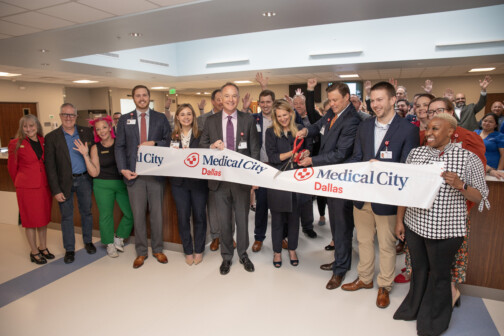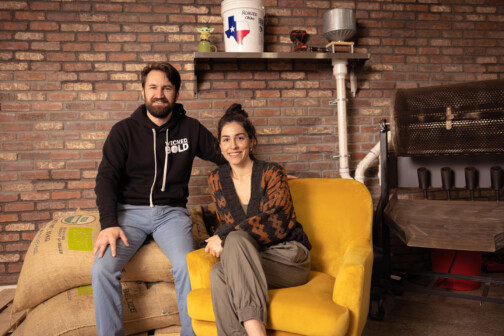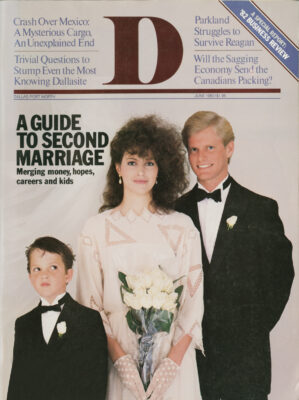Popular folklore has it that visitors and recent transplants to a new locale often have a more accurate perspective of their new digs than do the natives. The novices are able to cut through the hard sell, and they’re fresh enough to resurrect old charms that are all but forgotten by established settlers. (Partly for this reason, The Dallas Morning News for many years assigned the copy editor most recently arrived to the city to prepare the paper’s annual “Newcomer’s Guide” supplement.)
Each week during the past year, an average of 500 more new people have moved into the Dallas/Fort Worth metropolitan area than have left it, according to M/PF Research Inc. of Dallas. During the three years before 1981, the average net population gain was a thousand folks a week, a figure that explains the Central Expressway predicament. There are perhaps three million of us trying to get on that swollen artery or on Loop 820 in Fort Worth between 7 and 8 a.m. on any given workday.
In a metropolitan area encompassing 11 Texas counties, 161 incorporated cities and more than 8,000 square miles, the influx of 26,000 new people last year should scarcely have been noticed. But the new arrivals have been settling in concentrated areas that make their presence quite visible.
The concentrations are made apparent in a 1979 study by the Southern Growth Policies Board, which rated five Texas cities among the 15 fastest growing of all cities in the southern United States. Those five cities are all in the Dallas/Fort Worth area, and four of them are just north of the Dallas city limits.
One city, Piano, is the fastest-growing city in the South, which would have come as a surprise to the 3,700 farm-oriented people who populated it in 1960. Today, their numbers have grown to more than 60,000, and farming is the least of Piano’s commercial activities.
Piano, as the natives know, is 18 miles due north of downtown Dallas. Between it and Dallas lies Richardson, which was a bedroom suburb of 16,800 inhabitants in 1960. It now has more than 72,000 people, and the bedroom is noisy. Garland, just east of Richardson and northeast of Dallas, was home for 38,500 people in 1960; it now has almost 140,000 people. Farmers Branch, immediately west of Richardson and north of Dallas, has grown from 13,400 people in 1960 to 30,000 people. Arlington boasted 44,800 residents in 1960; about 152,000 live there now.
These communities are the scene-steal -ers in a general wave of population growth that averaged a 2 percent annual increase for the entire Dallas/Fort Worth metro-plex during each of the past five years, escalating to 2.7 percent last year. It’s expected to hold at around 2.2 percent each of the next five years, which is more than twice the growth rate expected for the United States. Dallas/Fort Worth already ranks fifth in total population growth among the nation’s 20 largest Standard Metropolitan Statistical Areas (SMSAs) between 1970 and 1978.
What’s the attraction? Well, it isn’t so much the Sunbelt climate comfort as it is the jobs. There are still jobs here -about 1.7 million of them in manufacturing and other non-farm employment – and just about anyone wanting work can find it. True, your perspective may be a bit jaded if you’ve just been laid off by Braniff or Texas Instruments, but our 5.2 percent unemployment rate (March) compares favorably to 9.4 percent nationwide and 15.5 percent in Eugene, Oregon (Aren’t you glad you’re not a lumberjack?).
The locations of those jobs are important. They’re not in electronics and airplanes, obviously; but the service sector – food, insurance, computers and healthcare skills-is still hot. Dallas/Fort Worth rates number four in the United States as an insurance company headquarters. It’s got an airport that could become the world’s leading air cargo carrier center by mid-decade. The Dallas Market Center, with 7 million square feet, ranks as world leader in wholesale merchandising space and the top market nationally for home furnishings, gifts and floor coverings.
There are places to see and things to do; more than 1.7 million conventioneers spend $450 million each year to take in the sights. Some are so smitten they come back to stay.
And that has made Dallas/Fort Worth big-big enough to collect approximately $22.3 billion in domestic bank deposits during 1980. That’s almost double the $12.23 billion recorded in 1975. And it’s a community of big spenders – ninth among the top 20 SMS As – spending more than $14 billion on retail goods in 1980, better than 33 percent more than the $10.3 billion spent in 1977.
Inflation is a continuing problem. The area’s inflation rate, as measured by changes in consumer prices, outpaced that of the United States by 1.4 percent in 1979, 3.4 percent in 1980 and 1.1 percent last year. It should continue to ride above the U.S. average for the next five years, according to data supplied by First City Ban-corp, of Houston.
The new homes now under construction in Dallas/Fort Worth average $82,000, compared to $68,000 two years ago and the current $69,000 average for most of the state, according to recent tabulations of the Texas Real Estate Research Center (TRERC) at Texas A&M University. TRERC economist Dr. Arthur Wright says we’ve got it cushy compared to Houston, where new homes average $87,600, but he cautions that the figures can be misleading where mortgage interest rates of 17 percent and higher are concerned. “Most of the houses sold have had some favorable financing help associated with them, such as a wraparound mortgage or seller financing or rate reduction for the first five or ten years,” says Wright. “The National Association of Homebuilders figures that seventy percent of homes sold [in 1981] had this kind of financing help.”
The strain placed upon municipal services and transportation arteries by the addition of so many warm bodies is considerable, particularly in the Dallas Central Business District. “We have a hundred additional automobiles coming into Dallas every day,” says Dick Hueholt, Dallas division manager with Lockwood, Andrews & Newnam, Inc., an up-and-coming architectural and engineering firm. (It prepared the feasibility study for a $357 million electrified light rail system from D/FW airport to Fair Park that is being pushed by Ben Carpenter, John Stemmons and Trammell Crow.)
Reiterating what he told Dallas Morning News reporter Si Dunn a few years ago, Hueholt says the mass transit challenges (and opportunities) in Dallas are considerable: “Central Expressway is handling the equivalent of eight lanes of traffic. LBJ Freeway exceeds its design limits by forty percent between Stemmons Free-way and Central. In two years, the cost of building highways has risen seventy percent.”
To compound the problem, there is 10 million square feet of office space under construction in downtown Dallas right now and 130,000 workers in the space that’s already there. The Central Business District Association estimates that the downtown work force grows by about 5,000 persons a year in “good” years but they give their forecast an extra oomph and project 190,000 people downtown by 1990. The bottom line is that there aren’t enough parking spaces for the 130,000-much less for those to come.
Even so, the news is not all bad, by any means. Despite having to bear higher-than-average inflation, the Dallas/Fort Worth SMSA lays claim to the lowest cost of living among the country’s 20 most populous SMS As. A family of four with intermediate income here can still make do with less than $20,000 a year, which at this moment cannot be said of any of the other top 20 cities, except Atlanta and possibly Houston.
Surprisingly, about 34 percent of the almost 700,000 households in the immediate Dallas area (excluding Fort Worth) had annual incomes of less than $ 15,000 at the end of 1981. This implies the presence of a great deal of rental activity while the achievers wait to climb the ladder. But only about 50,000 Dallas households, or 8 percent of the total, have yearly incomes of more than $50,000.
Apartment occupancy has thus remained high -more than 99 percent in the Duncanville-DeSoto-Cedar Hill area and in West Dallas. The Park Cities and North Dallas show 98 percent occupancy rates, and there’s scarcely an area in Dallas County showing less than 96 percent occupancy, according to M/PF. Ironically, fewer apartments are being built this year than in any of the last five years, when annual apartment additions averaged approximately 10,000 units. This year, we won’t make half that number; but that’s not entirely due to builders wanting to avoid 14 to 18 percent interest on their interim financing. A year or so ago, inflation-pinched renters started doubling up to share housing costs, and the resultant sub-par occupancy figures (under 93 percent) sent false signals about real needs of tenants. Those wonderful $200-a-month garage apartments are still extant in Lake-wood, Oak Lawn and parts of the Park Cities, but most tenants end up paying an average of $345 a month, excluding utilities, for a one-bedroom apartment. Escalating steadily since their $ 180-a-month average in 1975, rents are not likely to come down, even in the face of the freer mortgage money and loosened interest rates.
Like populations elsewhere, the majority of Dallas households (58 percent) fall into middle-income brackets somewhere between $15,000 and $50,000, and there’s plenty of housing available – new and used – to suit both their incomes and lifestyles.
Condomania hit the area rather solidly last decade, with more than 7,400 units in 122 apartment projects converted to con-do-almost half of those in the decade’s last two years. The first three years of this decade continue the trend, with 1981 showing more than 5,600 condo authorizations, a 73 percent increase over 1980 tallies, and 1982 expected to produce 6,200 condos and town houses.
The big difference between housing in the Seventies and housing in the Eighties is that three-fourths of the condos sold now are brand-new, in comparison to the number of converted apartments, which dominated the Seventies scene. Most apartments built in Dallas are designed for a 15-year life (a measure of their maintenance requirements, not how long they’ll stand), and some earlier condo buyers were understandably miffed about buying a product that required almost as many maintenance dollars as the monthly mortgage.
Today’s “garden condos” do not require such extravagant maintenance fees, and they’re frequently as inexpensive to erect from scratch as older buildings are to convert. In Dallas, they can be had for as little as $30,000 (count those on the fingers of one hand) or as much as you’d care to pay; the median price (for April through October of last year) is $61,000 – a considerable savings from the aforementioned $82,900 new single-family average home price in Dallas/Fort Worth and even higher $94,700 single-family home price for Dallas proper.
“There are more varied, more diverse choices for the small-income buyer than ever,” says Ron Witten, president of M/PF Research Inc. “Some builders have gone duplex, like Fox & Jacobs and U.S. Homes. F&J’s Today II product starts at around $39,950, with two bedrooms, one bath, and front and backyards. You’re also starting to see a little manufactured housing offered in subdivisions. You can now get a 30-year mortgage on manufactured housing, with brick around the base of it, and get it for anywhere from the high $20,000 to the low $30,000 range.”
New single-family housing doesn’t have to cost an arm, a leg and the aforementioned $82,900 “average” that exists as a result of balancing the hot-growth executive communes north and west of Dallas with the more affordable tracts ringing the southern vistas of the Metroplex.
“People who are just moving into Dallas now can see that they can buy the same house in DeSoto or Duncanville for $20,000 to $40,000 less than they can get it in Richardson or Piano,” says Dr. John Rees, associate director of the Center for Policy Studies at the University of Texas at Dallas. “You’ll see the southern part of the Metroplex is going to make a comeback similar to that which the southern United States has made relative to the North.”
Arlington and Fort Worth are already seeing the major industrial and single-family housing expansion turn southward, where an important interstate arterial (I-20) ties together Fort Worth’s outer Loop 820 with Dallas’ Loop 635. Halfway between, at Arlington, State Highway 360 provides smooth northward access to D/FW airport while also bisecting the 7,000-acre Great Southwest Industrial Park, the nation’s largest industrial park.
Because it’s a quarter of a century old, Great Southwest park rarely earns the headlines of a Metroplex on the make for anything new, but it employs 30,000 people in 640 companies and encompasses offices, hotels, restaurants and Six Flags Over Texas (which, incidentally, now outranks the Alamo as the state’s number one tourist attraction).
Great Southwest is simply the largest of approximately 135 business and industrial parks in Dallas County and 70 in Tarrant County. The numbers are not as important as is the financing. The two anchor cities-the nation’s seventh and 17th largest, respectively -built their parks on the strength of private developers’ beliefs that they could make a buck playing their cards on those cities’ stature as transportation and population centers.
Some of the things Dallas, Fort Worth and their neighbors point out to suitors remain fairly traditional: proximity to D/FW airport, now the nation’s fourth busiest, and its expandable Free Trade Zone; the area’s high work ethic and avail-ability of semiskilled and skilled labor at relatively bargain wages; closeness to 50,000-plus acres of industrial-zoned property; and (for what it’s worth) the Sunbelt climate, offering practically year-round access to the 31 lakes located within a hundred miles of the area.
A new wrinkle has been added to thetraditional sell, however, and it was evident at the dedication of the new DallasCentral Library, during guided tours ofthe West End Historical District, and inalmost all press coverage of the developing20-block downtown Dallas Arts District:People are damned proud of the publicsector/private sector partnership in developing community projects -somethingthat’s been going on since Fair Park’s predecessor was installed last century, butthat has been publicly downplayed sincethe advent of single-member city councildistricts. Now, it’s no longer a politicalliability to look like a promoter.. .well,partner.. .of big business. It’s almost unpatriotic not to do so, because any citythat works right this decade is probablygoing to have to approach well-lined private pockets to fund what a dwindling taxbase and balky voters cannot entirelyshoulder publicly.
Get our weekly recap
Brings new meaning to the phrase Sunday Funday. No spam, ever.
Related Articles

News
Medical City Opens ER in Garland and Local Dermatologist Named Youngest Ever President of the American Academy of Dermatology
Plus Health Wildcatters wins accelerator competition and DFW Hospital Council Foundation awards.
By Bridget Reis

Business
Wicked Bold Chocolate CEO and Comedian Deric Cahill on Why it Pays to Be Funny
The brand leans into humor, but the business' success is no laughing matter, with products in nearly 2,000 retail locations nationwide.
By Will Maddox

D CEO Award Programs
Nominations Open: D CEO’s 2024 Corporate Counsel Awards
The annual program honors top in-house attorneys in Dallas-Fort Worth, from outstanding up-and-comer to outstanding general counsel.


